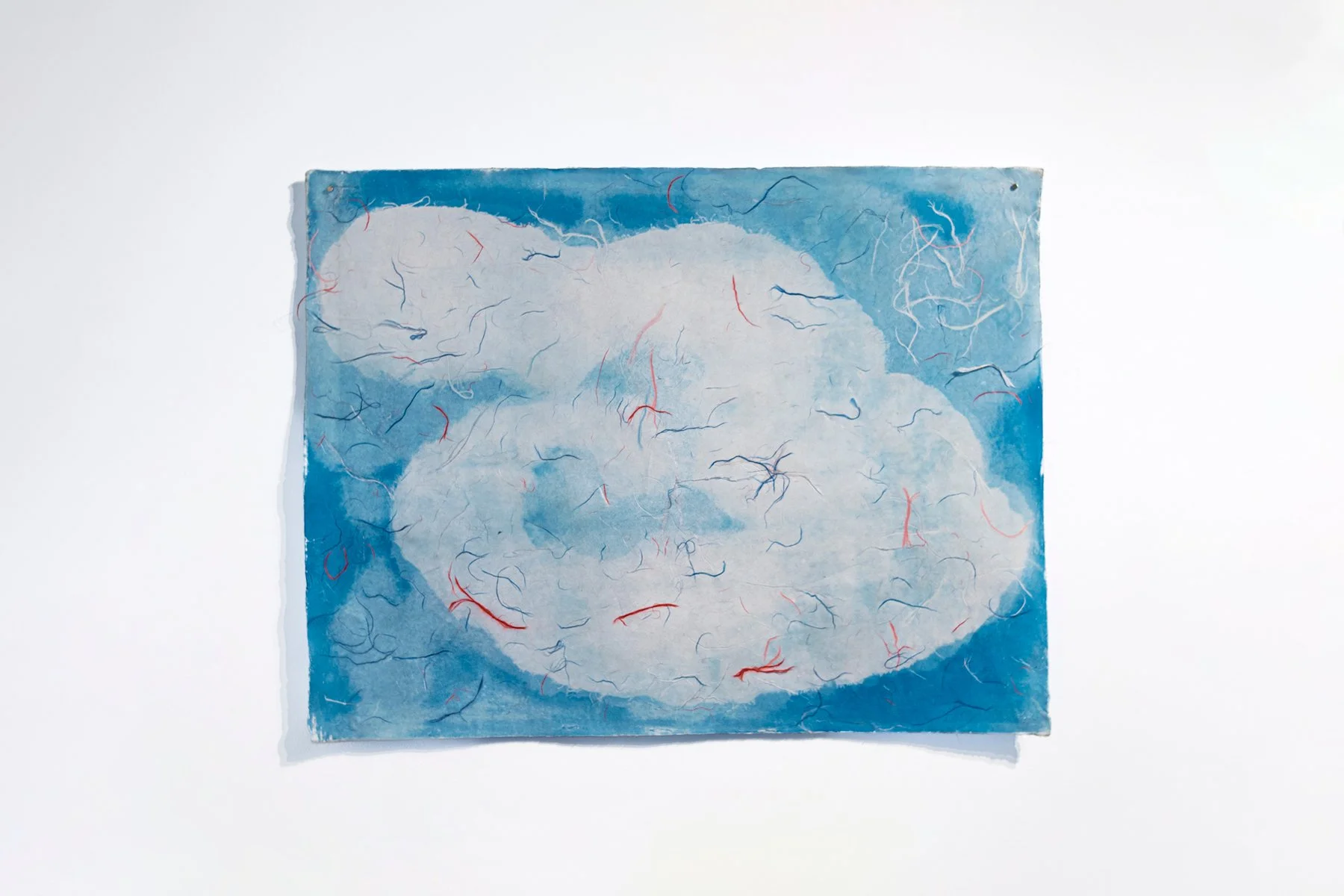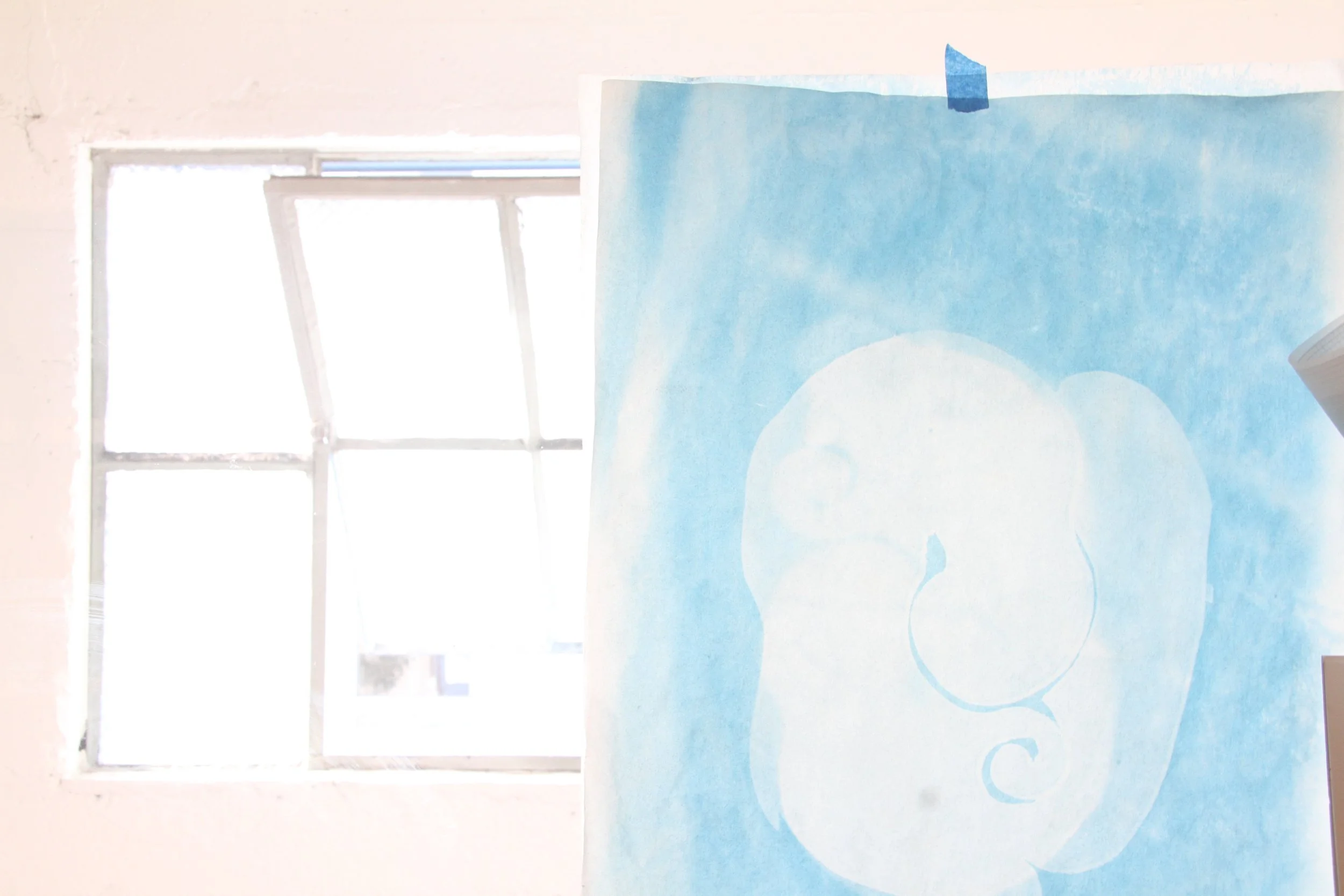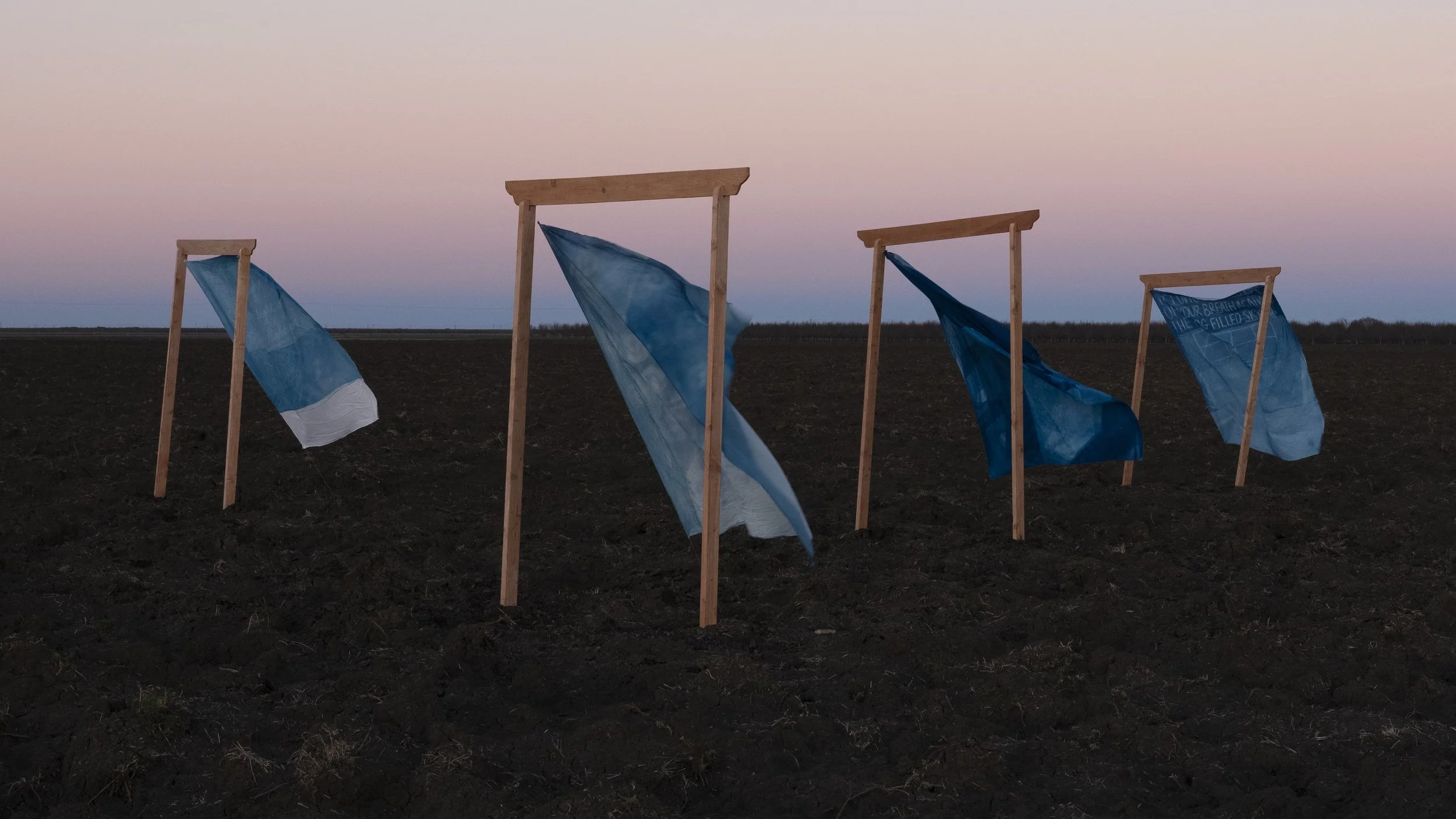March 28 2025
Photograph by Zabrina Deng
Dream/Bug:
An Echo Eroded by Light and Shadow
Tracing Time’s Residue in Cyanotype’s Delayed Emergence
Guest Elaine Nguyen Interviewer Yuchen Hou & Livia Xie Written by Yuchen Hou
January 5, 2025, 11:28 AM. Livia and I finally arrived at Root Division, where Elaine greeted us at the entrance, wearing a blue and white striped shirt. She led us upstairs to her small studio.
The first thing that caught my eye was a series of new cyanotype works hanging on the wall. Their materials varied—some on fabric, some on paper, and others on delicate gauze. The surfaces differed as well: some had a grid pattern, some were washed in a uniform deep blue, while others were streaked with red, vein-like lines. At the center of each piece was a hazy, organic shape. It reminded me of the facehugger from Alien. Was it a creature? An abstract symbol? Since Elaine is Asian, I wondered if this form could be a stylized transformation of traditional cloud motifs. Before I could ask, I thought to myself.
"Dreambug," Elaine said.
Sleeping Dreams I am searching for..., 21.5" x 30", Cyanotype on Handmade Paper, 2024
She had created this shape as early as 2023, but at the time, she hadn't known what it was.
"I felt like some were more like creatures. I have a bunch of these different plexiglass and fabric shapes I had cut. At the time, I didn't r eally know what they were. In Davis, 2023. Then I just like kind of saved the project because it didn't become anything. I carried it around for two years."
It had continued to resurface in her work, as if it were something difficult to process.
"I think what I'm interested in, in the repetition, is this idea of regurgitation. If you were to eat a cupcake, first, it's a cupcake. You ate the cupcake. Now it's in your belly. You threw it up. Now it's vomit, but it's still a form of this cupcake. And then if you try to put it back together with more flour, now it's this other thing. You let it sit and it starts to rot. It's now something else. So it's kind of like this—how many ways can you make the same thing and have it still be interesting to you?"
She emphasized repetition. She emphasized regurgitation as something integral to this series. Dream/Bug kept appearing, like a fragment of a recurring dream, or a lingering experience that could never be fully digested.
"I have a Turkish friend," she said. "She once told me a folk story—that whenever you sleep in a new place, your first dream determines what that place will be for you."
She mentioned that in 2023, she had fallen ill, and lacked the same mobility she once had. Doctors have yet to pinpoint the exact cause. She described the experience as a kind of entrapment and later felt that imagining this illness as a bugs made sense to her. She never explicitly stated that Dream/Bug was directly derived from this bodily experience, but the bugs, as a metaphor, repeatedly appeared in her work.
As I listened, my thoughts drifted toward the material qualities of cyanotype and how they seemed to resonate with the atmosphere of her work.
What makes cyanotype unique as a medium? Why did Elaine transition from painting and sculpture to cyanotype? As a photographic process, cyanotype has the ability to preserve an image for a long time, yet what it captures is never sharp or definitive—it often appears as a hazy imprint, like a memory settling into light and shadow. If cyanotype were to be understood as painting, then light would be its pigment, and time would dictate the way the image emerges. Its strokes are blurred, fluid, never fully controlled.
I suddenly realized that the difference between cyanotype and painting is not just a technical one, but a temporal one. In painting, each stroke is an active accumulation, a deliberate mark-making process. But with cyanotype, the image is formed through waiting. It is not an instantaneous capture like a shutter click; rather, it is a delayed manifestation, a residual imprint left by the interaction of light and material. Dream/Bugs is not a fixed symbol but something closer to an echo—something shaped by light’s erosion over time.
Blue Hour
Elaine said she likes cyanotype because it reminds her of the sky and swimming pools. She described the experience of working with cyanotype as momentarily stepping into an alternative reality—like plunging into water, feeling clear and weightless, yet slightly detached.
As she spoke, I looked around her studio. Her worktable was covered with cyanotype-treated ceramic pieces and postcards featuring her past works. This reminded me of Blue Hour, her piece that I had seen during her MFA graduation exhibition.
At the time, her work had struck me as romantic, hazy, tinged with a slight melancholy. But now, looking back, I realize that my perception was incomplete.
Before leaving, Elaine demonstrated how she used a UV light to develop her Dream/Bug pieces. I glanced out the window toward the overgrown courtyard and asked, "Do you still create outdoors?"
She said she had shifted more toward working indoors.
Blue Hour
I remembered the first time I spoke with Elaine, back in early 2023, in the backyard of the ceramics studio. Before that, I had only seen her walking briskly between the Art Building and TB9, always dressed in blue. My knowledge of her stopped there. That day, she had laid down a long sheet of paper beneath the trees, securing it to the ground before pouring a thin layer of pale green liquid over it. When I asked her what she was doing, she told me about cyanotype.
Later, in Annabeth’s contemporary art course, I learned about the history of cyanotype—how Anna Atkins had used it to create botanical records, turning it into a tool for capturing images. I also attended Elaine’s pre-graduation talk, and in the summer of 2024, I saw her works Blue Hour and Ngoại ăn, Ngoại có sức khỏe at the Manetti Shrem Museum’s graduation exhibition.
Blue Hour originally refers to the brief period of twilight before sunrise or after sunset, a time of rapid, unstable shifts in light.
I had thought it was romantic, but now I wasn’t so sure. I thought about her illness, her Dream/Bug metaphor, her descriptions of waiting.
There is certainly something romantic about Blue Hour, but that romance isn’t light or delicate. Elaine captures the most uncontrollable moments of time, and the nature of cyanotype itself reinforces this instability. After this studio visit, I began to suspect that its romance isn’t about tenderness, but rather a form of honesty—a way of staring directly at an irreversible transformation.
Guest Elaine Nguyen Interviewer Yuchen Hou & Livia Xie Written by Yuchen Hou Studio Photo by Livia Xie
People also read…
Article
Nov 8 2024
Blue Shackles: A world we cannot destroy
To the artists, the female body, like the world, is full of contradictions.
Blue Shackles by Various Artists
Article
Feb 7 2025
Between Clay and Ceramics: Tianzong’s Contemporary Koan
Is clay the foundation of creation, or a silent act of resistance?
Images courtesy of Tianzong








